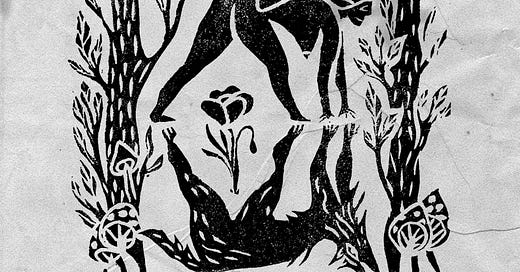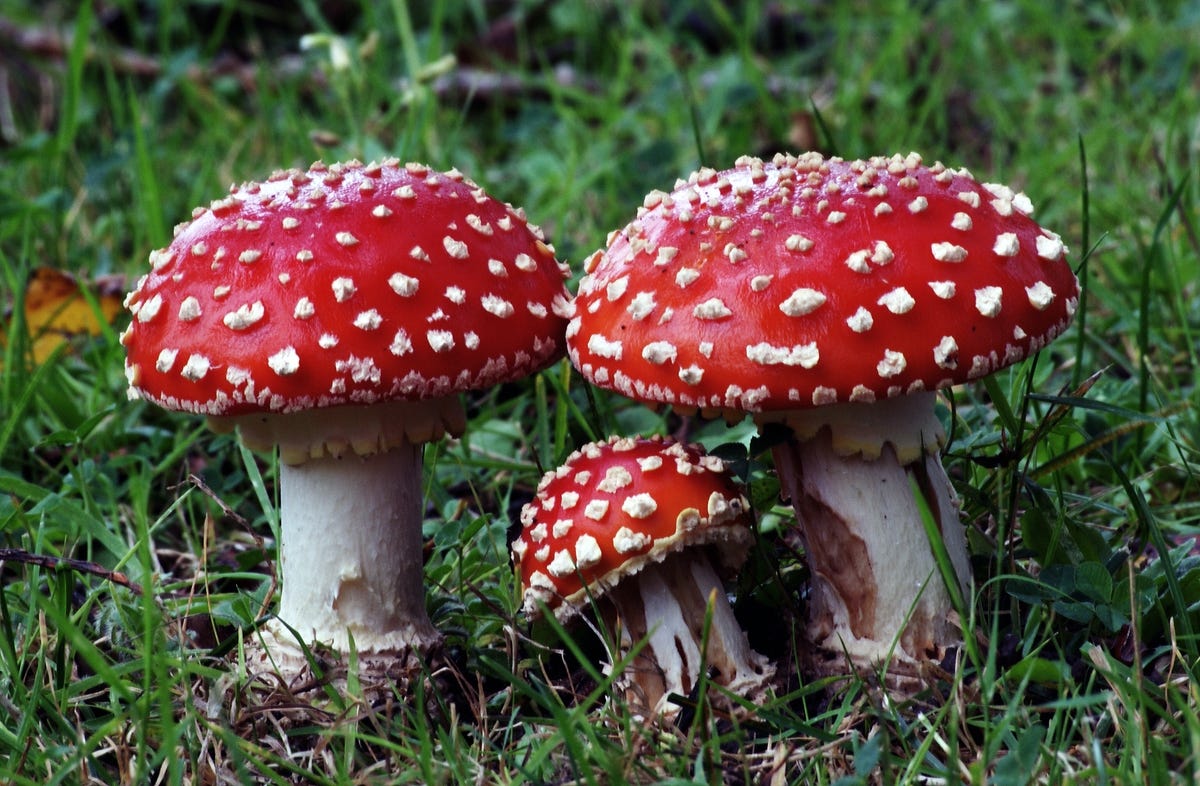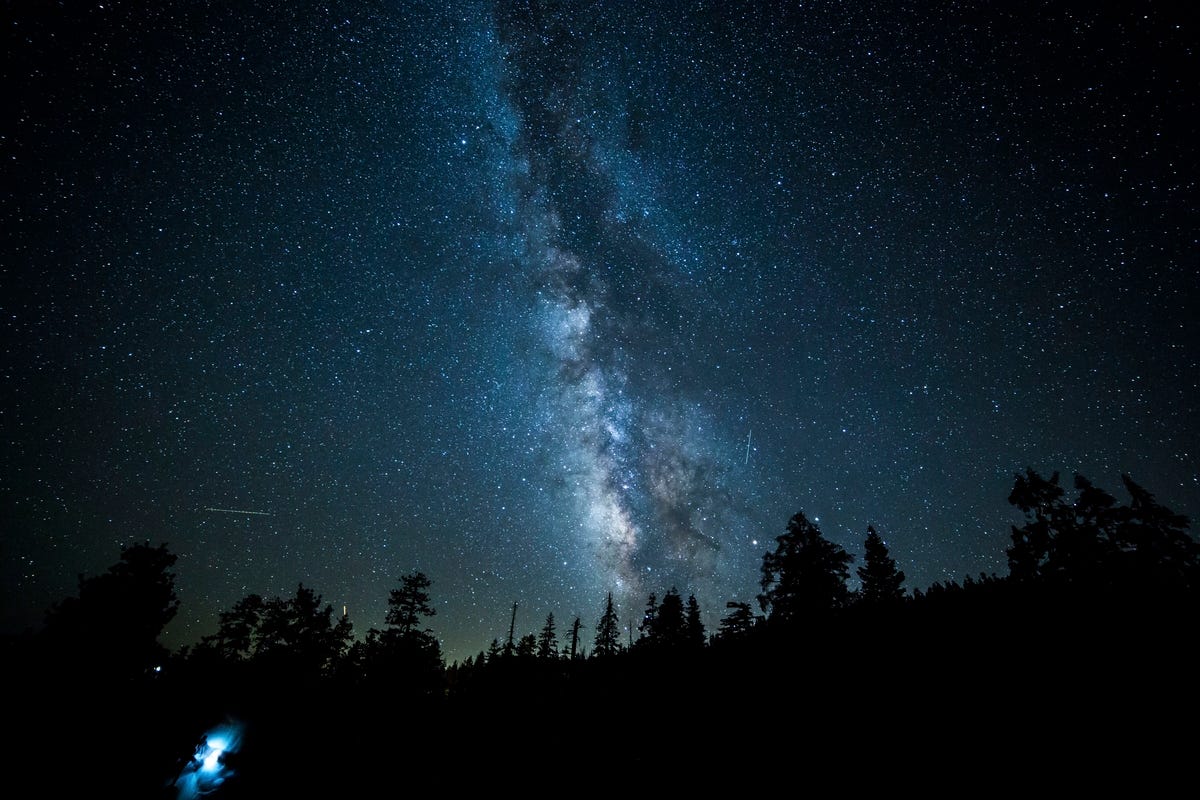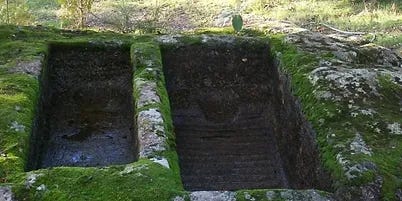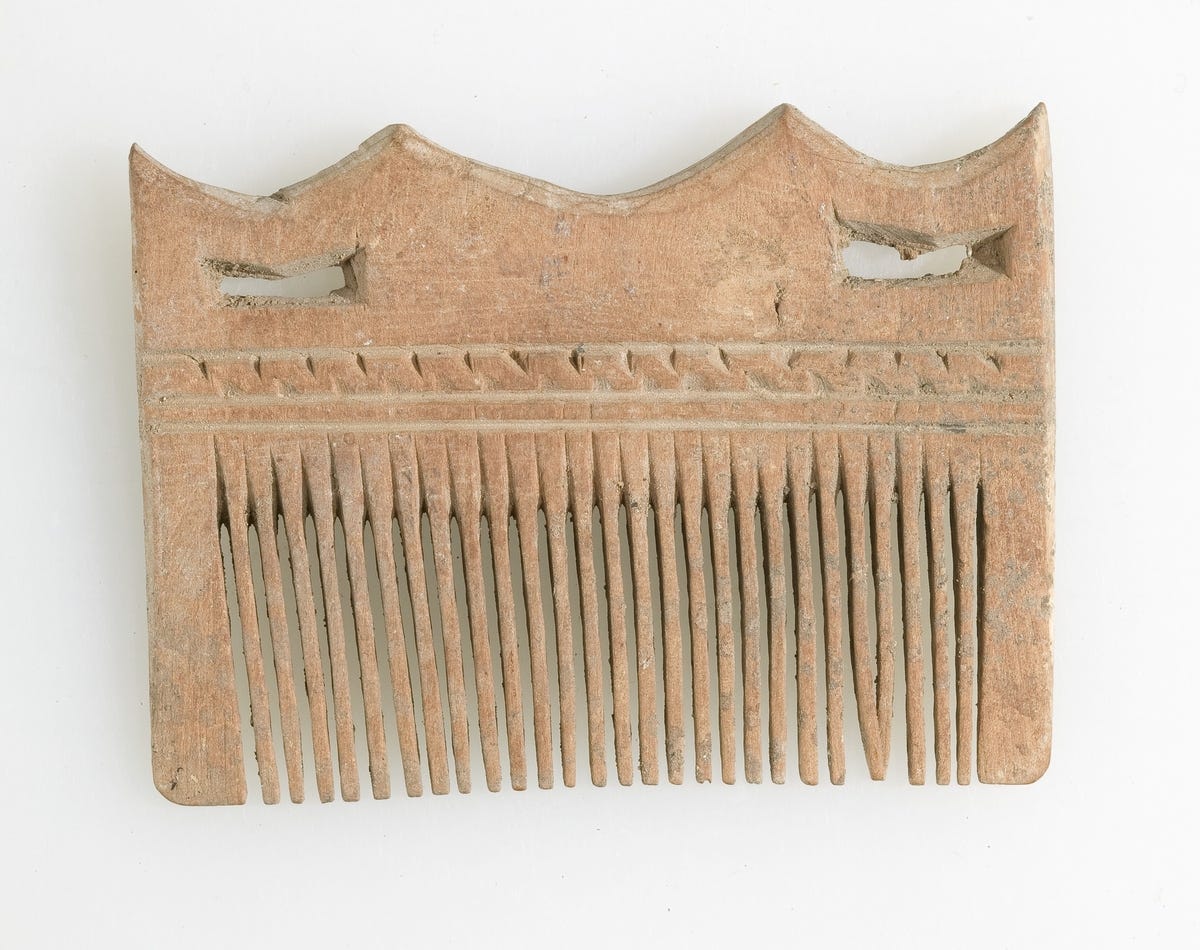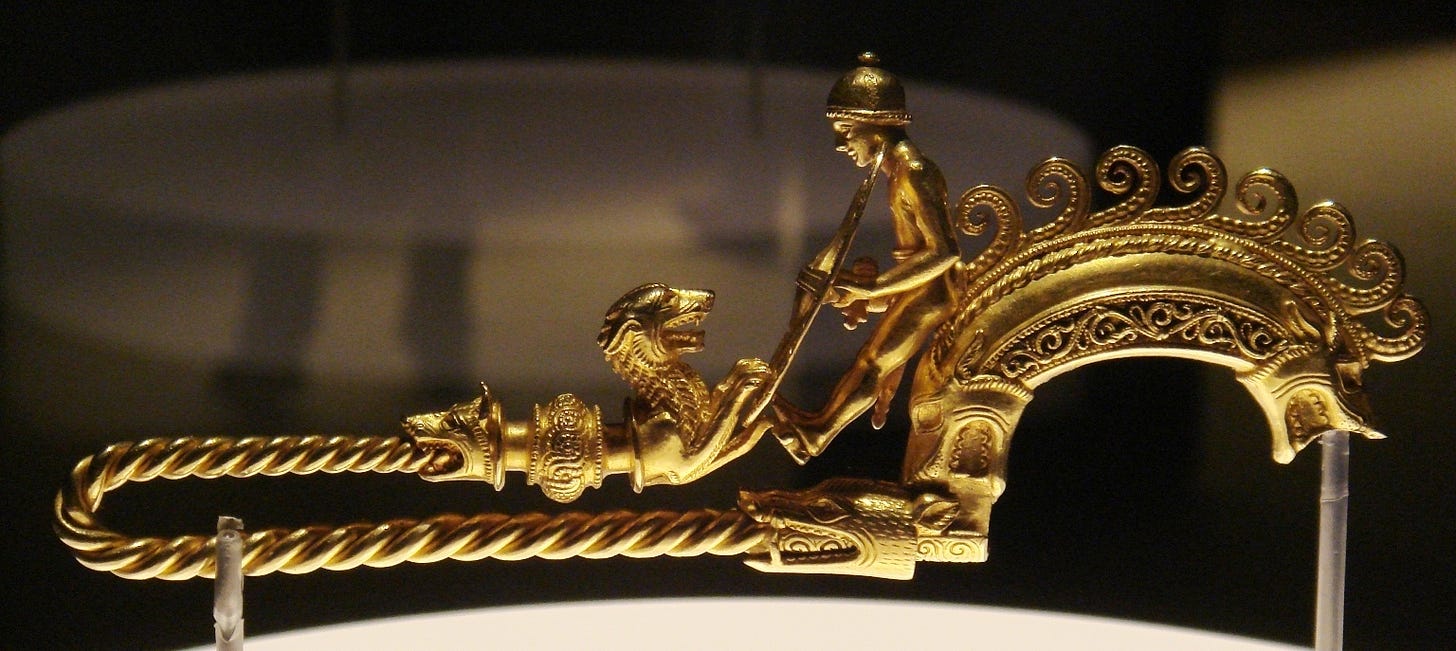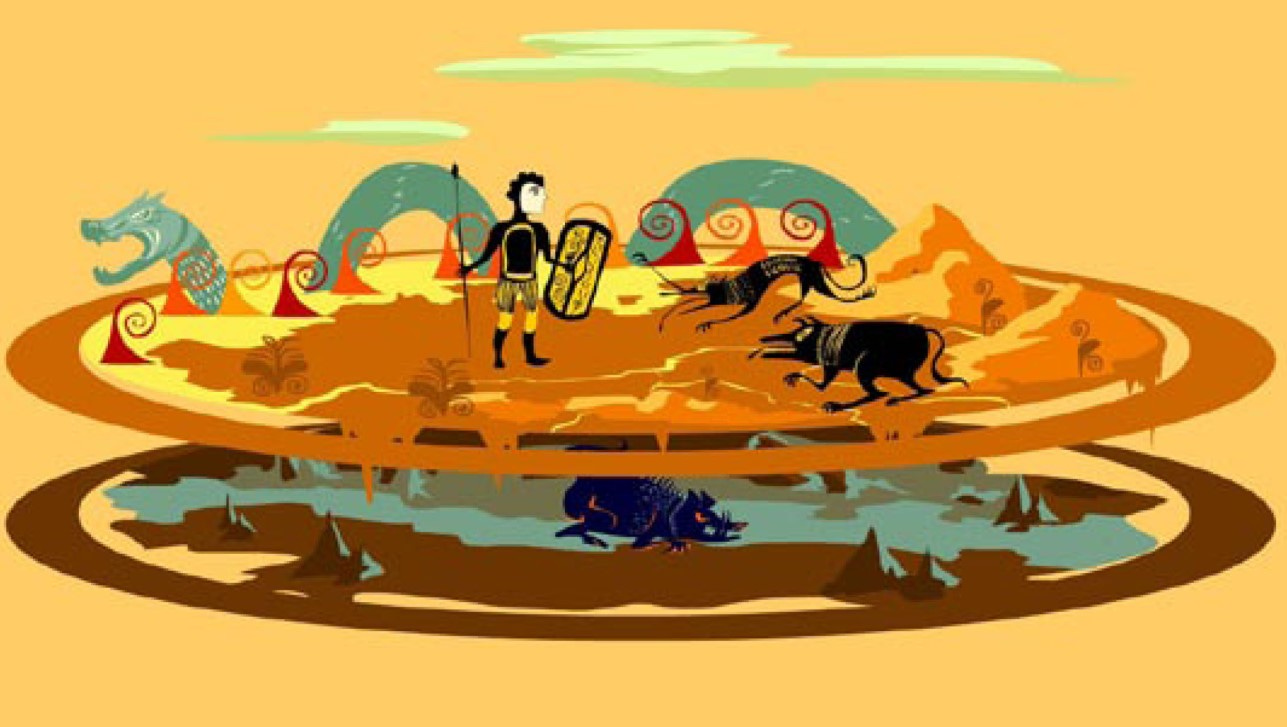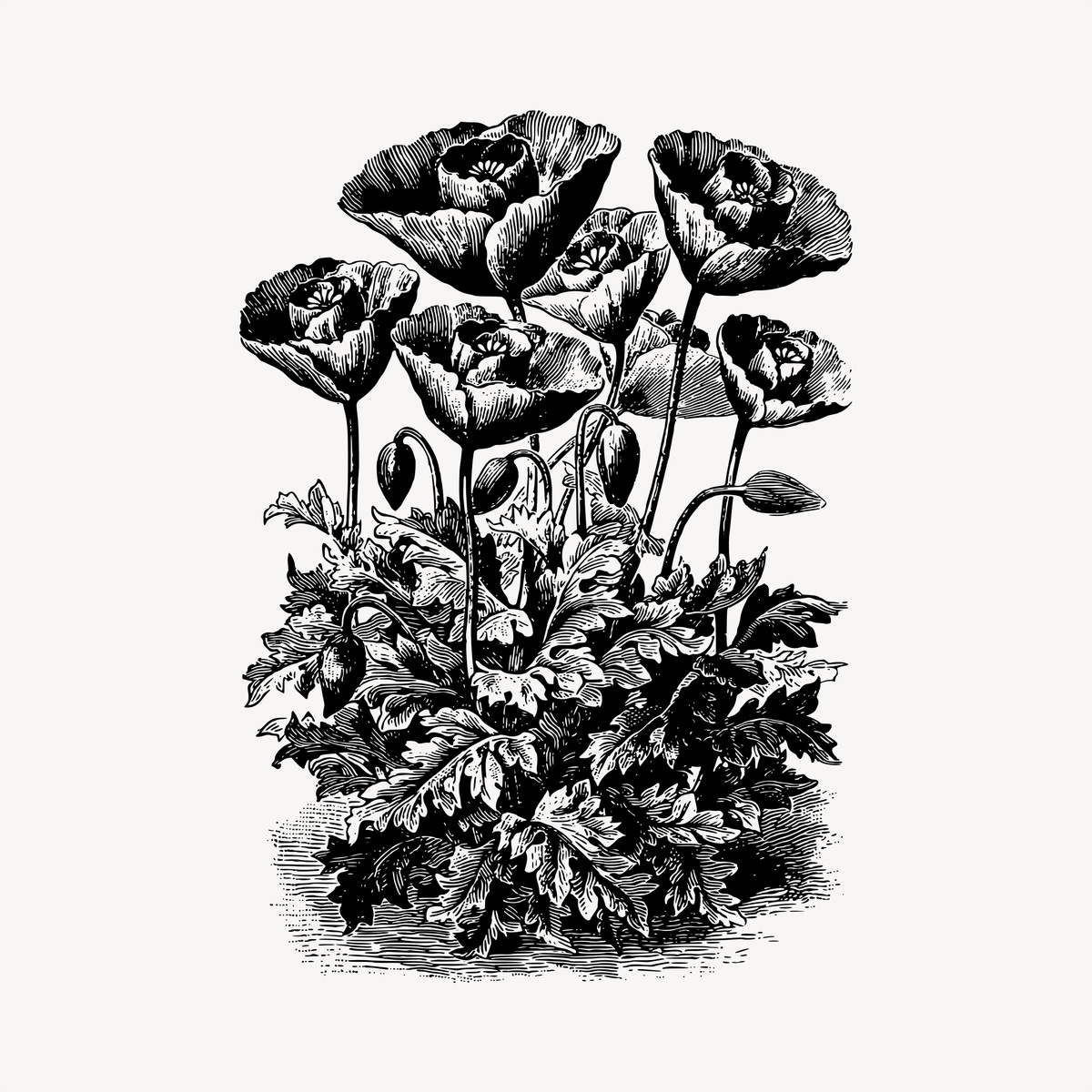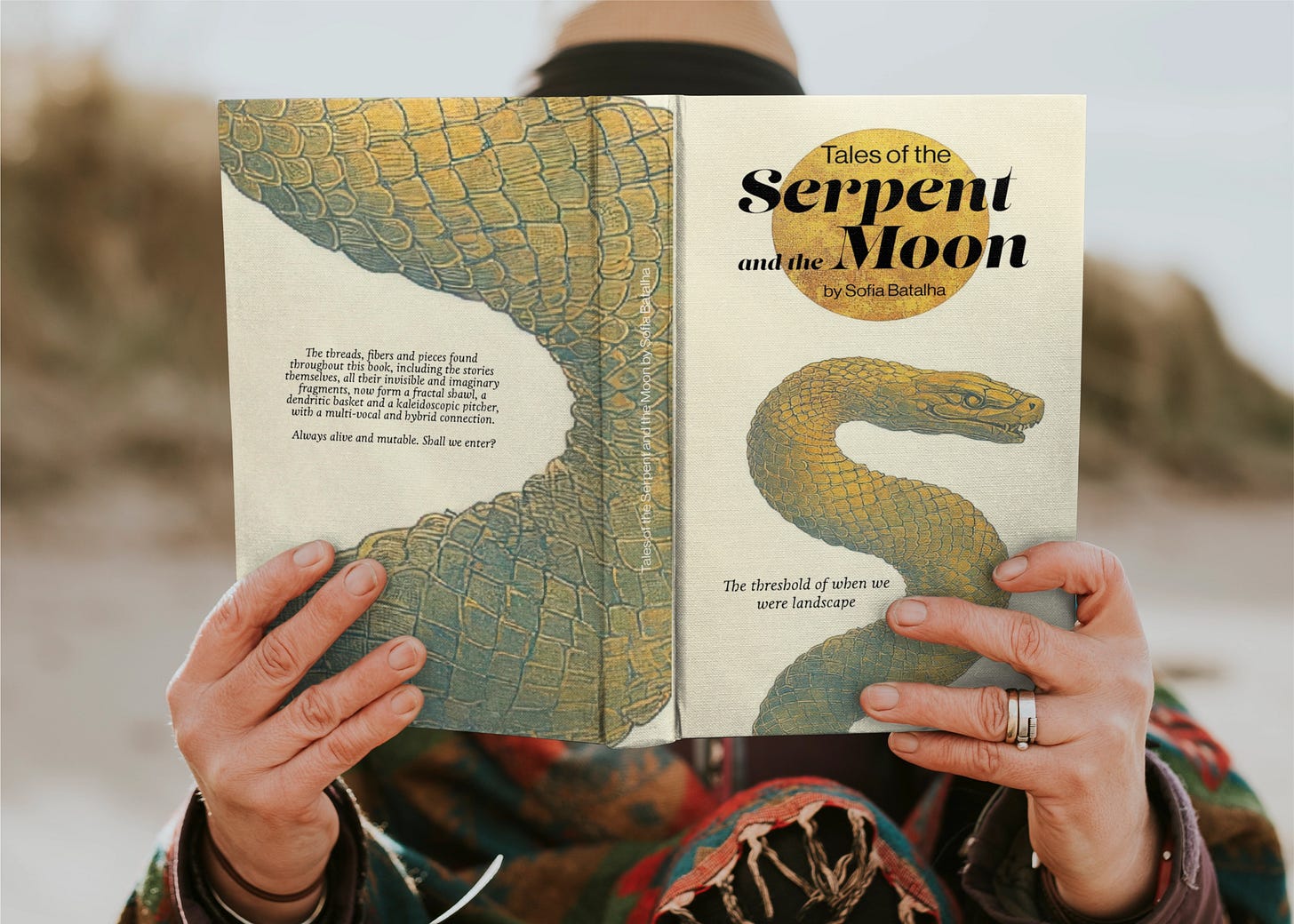Dear reader,
Please note that the content shared here on Substack will differ from what appears in the printed book. While many of the themes, stories, and inquiries may echo across both formats, the book itself has undergone a thorough process of review, editing, refinement, and expansion. In that sense, the printed version holds a more curated, deepened, and embodied iteration of the work.
Think of the Substack as a living ground, where ideas are still fermenting, evolving, and growing their tendrils. The book, meanwhile, is a vessel, harvested with care, ripened in its season, and offered as a more coherent ceremonial bundle.
With tenderness for the ongoingness of becoming,
—Sofia
The Story
Ananta, the young she-wolf, was used to following the Red cloak Woman across the fields, mountains, and woods. Her wolf grandfather had also walked beside this peculiar woman who spoke the primeval language of stones, plants, and animals. Ananta especially likes it when Amanita, the Red Cloak Woman, also turns into a wolf during the three nights of the full moon, because then they can frolic together, tumbling around on the ground in the poppy fields, among playful kicks and bites.
The black wolf pack lives with Priestess Amanita in the mountain cave and, from there, they hear the ancient stories of the abysses, the clamours from the ground, and the melody from the stars.
Ananta, young and curious, tirelessly explores, with her keen senses, every nook and cranny of the places they walk through. She feels the vibrations in the ground up through her paws, the electricity in the air in her fur, the tiniest sounds with her ears, the subtlest and most distant scents with her sensitive nose, and glimpses the most seemingly insignificant movements with her wild eyes. The She-wolf knows the cycles and knows there must be a rhythm to every action.
Many years ago, when the Priestess' grandmother still lived with the wolves in a little hut in the forest, and before she passed away, the wise old woman taught Amanita the forest's ancient rites and secrets, and Amanita inherited her blood-red cloak, having begun her learning at age twelve. Her grandmother prepared her for listening and observing, but she also taught her the language of plants and waters and the skill to move between worlds.
Exactly as she had practiced with the old woman, during the three days of darkness in each month, Amanita and her pack pay a visit to the wild boars of the depths and the serpents of the waters, bringing offerings of mushrooms, hazelnuts, and grapes.
During these meetings in the deepest darkness, the She-Wolf Ananta keeps at a distance, uncomfortable, with raised hair standing on end and growling in a low voice. Every time, Amanita calmly reminds her that poppies wouldn't ever bloom without these visits. And every time, Ananta nods a silent assent but never quite relaxes.
In one of these dark reunions, the She-Wolf walks under the starry night sky to release the tension those gatherings instill in her. After some time, she senses a strange odour and some unusual sounds. "Human", she thinks as she sniffs the night air, and her eyes find him.
Her protective instinct makes her watch him intently and intensely. The man is trying to hunt with his sling, in the cover of darkness, but feels watched and disturbed. Suddenly, their eyes meet. The She-Wolf reads the terror in the young man's eyes and feels her muscles tense up, ready to flee or fight. She can smell his fear. Staring him down, an unmoving Ananta growls to keep him at a distance. He chooses to run, trusting the enveloping darkness of the place, despite the She-Wolf being easily able to distinguish his scent and the sound of his running body. The young She-Wolf had never seen a human that close before.
~~~
A few days later, on a brightly moonlit night, as she plays with the priestess in wolf form in the poppy field, deep, guttural grunts from the cliff edges take them by surprise. They run over to the place, guided by the stench of fear and tension, coming across three wild boars charging against a lone man. He defends himself as best he can despite being at a distinct disadvantage. Ananta and Amanita, with their eight paws, surround the boars and the man, snarling with raised fur.
Their black-furred bodies, powerful and robust, their bared teeth and sharp claws, draw a protective circle around the wounded young man, finally driving away the boars, who retreat in displeasure. The man lies on the ground, inert.
Sniffing, Ananta comes closer, recognizing the scent of the human she’d come across before. The She-Wolf smells his blood trickling from one leg and instinctively licks his open wound, cleaning it. The boy jolts and wakes up startled, shivers running up his spine. “She’s going to eat me,” he thinks fearfully. Their eyes meet again, and there’s mutual acknowledgment. “The Wolf who growled at me the other night,” he concludes quickly. Looking into her wild eyes, he understands he won’t be eaten at all and loses consciousness soon after.
For three days and three nights, Ananta does not leave his side, keeping him safe and warm, and cleaning his wounds with her wolf tongue. Amanita assists by giving him a drink of poppy seeds and dandelions, which keeps him calm and helps his body stay strong enough to heal.
When the young hunter wakes up, he finds himself lying at the cave entrance, with the large She-Wolf lying at his feet. He feels weak and confused: on the one hand, he should get up and run as fast as he can; on the other, he feels comfortable and protected right there. He tries to get up, and sees that his wound has been well-cleaned and mended, but quickly loses strength and falls back onto the ground. The She-Wolf awakes from her slumber and lies down again next to him to soothe him. The boy feebly raises his arm, venturing to touch Ananta, stroking her fur. She awkwardly but quickly allows it, laying her head over his chest.
One month after the attack, it is the Full Moon again, and the hunter feels much stronger. He and Ananta are now inseparable, spending their days together in deep, wordless communication. That night, the Priestess Amanita, always observant, whispers to the She-Wolf as she strokes her ears: “Tonight we switch!”. And, in that very moment, the she-wolf turns into a beautiful young woman with black hair, under the hunter’s stunned gaze.
They both walk out onto the poppy field, hearing and touching each other in the bright moonlight. Both ecstatic and astonished by that force that unites them in harmony. Both were amazed and perplexed by each other's body and soul company. The hunter and Ananta, the wolf, now a woman. They fall asleep curled up into each other, and awaken the following morning, the spell has already worn off.
Feeling the profound love that binds them together, they consult the red cloak priestess, asking how they can become one, and how can Ananta’s transformation last a little longer? Amanita tells them of an ancient connection ritual: the young man will have to go, on his own, to ask for permission from the cave wolves, the night wild boars, and the water serpents, for such a union needs the primal power of the depths. After the consent to join with Ananta has been granted, they’ll both have to lie down together in the forest crags’ rock basin on a Full Moon night, and wait.
A few days later, the young, enamoured She-Wolf lets her lover go in search of the approval of the beings of darkness. A deep-dwelling fear raises her fur, a fear he’ll be attacked or killed by powerful wild forces. He clears the way with an open heart, full of that love that nourishes him, certain that the powerful ancestral beasts will accept him.
After walking for three days and three nights, through marshlands and mountains, tired and thirsty, he finds the beings he seeks, gathered in council in a clearing of stones. “We’ve been expecting you,” they hiss, growl and grunt. They all stare at him intently, making him uneasy. “You dare claim Ananta’s love?”, demands the largest wolf he’d ever seen. “What do you have to offer, frail human?” the large wolf continues, eyes unmoving from the human’s own. “I offer my life and my heart,” the innocent young man replies wholeheartedly. “Prove it. Take your clothes off. Lie down there.” the wolf commands him in a low growl, and shows him a hole in the ground, freshly dug by the wild boars.
The young man does as he’s told, leaning his naked body back against the shallow hole’s stony ground. The snakes close in, coiling around him and squeezing him tightly, while the boars cover them with earth. The wolves stand in a tight circle around the hole. The hunter doesn't know how long he was immobilized and covered, for he let himself be held, trusting his surrender and the love reciprocated by the She-Wolf. When he awakens, it’s already daytime, and he’s elsewhere; his thirst and fatigue are gone, and he knows he’s passed the test, because he’s holding an enchanted object in his hand: a stone comb. He runs, faster than he ever did, toward the stone basin in the middle of the oak and hazel forest. When he gets there, he finds Ananta anxiously awaiting him, and she brushes her wolf body against his skin.
They ritually bathe together in the water-filled stone basin. The boy knows he will have to use the comb to brush the She-Wolf, as instructed to him in the visions of the previous night, and gently does so, untangling the black fur. She growls at him when he pulls too hard. The sun sets, and he continues to comb her fur with infinite tenderness and patience. Sometime during the night, Ananta's fur begins to fall out with each tug, revealing soft skin underneath. At dawn, they are both asleep in the stone basin, and the bunches of fur have turned into black poppies that sprinkle night all around, glistening in the morning sun. In the stone basin are now nestled two human bodies, blessed by primal water and enraptured by the love that unites them.
Ananta and the hunter lived together for the rest of their lives, with their children nurtured by the creatures of the forest and the Red cloak Priestess. The She-Wolf Ananta has not lost her keen senses, for the trembling of the ground on her feet, or the electricity of the air on her skin, and continues to pick up the tiniest sounds, the subtlest smells, and the most insignificant movements with her wild eyes.
On full moon nights, she claims her wolf skin and plays in the fields of moonlit poppies. She learned the ancient rites and languages from Amanita, continuing her legacy as guardian and intermediary of the thresholds.
After the story, please take some time to feel how it relates to you and what unfolds and resonates with your unique context.
Let's breathe.
What breathes through the tale
What follows is not a symbolic interpretation of the tale, exiling it in a single narrative. There is a unique symbiotic dialogue with its living layers that is yours to feel, sense, and travel through. The following words are mythical, historical, and place transcontextual information that resonates with the tale pulsing realm.
This tale began intending to do a creative rewrite of Red Riding Hood, but it gained a life of its own and opened the way to other landscapes.
Little Red Riding Hood
As the original story of Little Red Riding Hood is a tale of the ritualisation of menstruation and first sexual intercourse through initiation rituals, I wanted to bring a perspective that unraveled from the original threads of the story. The original version of the tale was worked over centuries by patriarchal prejudices, denying women any success or advantage, and portraying them as helpless victims who need the woodsman to save them. The Grimm brothers' narrow understanding of the tale contributed to this, limiting it to a narrative of the "right path" imposed by the mother, which the girl must follow without deviation, in a linear moral that ignores the ancestral initiatory rituals imprinted into the story. In one of the more archaic versions of the tale, the girl and her grandmother prepare boiling cauldrons in which the wolf ends up falling and dying, and it is they who solve the whole challenge by themselves. I should remind you that boiling cauldrons in tales have connotations with witchcraft and spiritual transformation rituals. Several patterns in the Little Red Riding Hood story indicate its animist and shamanic antiquity.

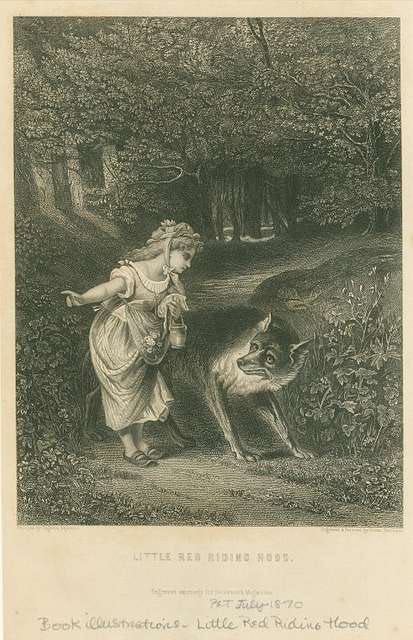
The basket
First is the basket, a symbolic image linked to mysterious secret rituals. In the basket the little girl carries: apples or round cakes, and wine. Little Red Riding Hood's traditional basket is equivalent to the basket used by women who went out to collect mandrake, taking with them eggs, cakes, wine, honey, and bread. Far from civilization, the mandrake collected in the deep forest constitutes the culmination of their initiatory journey. Like the mandrake gatherers who adorn themselves with red ribbons as they enter the forest, the girl and her red cloak meet the wolf in the forest.
The grandmother
Secondly, the figure of the grandmother represents the wisdom of the old woman, resulting from the triadic pattern of the feminine —maiden, mother, crone. Like the mandrake, the grandmother's house is deep in the forest. There, the ecstatic culmination occurs, the shamanic union between humans and animals, the alchemical unification and metamorphosis.
Lycanthropy
Third, the archaic pattern that is only seen in the light of shamanism relates to lycanthropy, a term that comes from the Greek, lykos, meaning wolf and anthropos, meaning man, i.e. werewolf. The wolf is a powerful archaic entity, a chthonic raptor, who blows through caves and hollows, activating howling subterranean winds, transporting souls to the underworld (the metaphorical pattern of the blowing wolf in the story of the Three Little Pigs). The symbolism of the wolf also relates to prophetic, ecstatic, and shamanic inspiration.
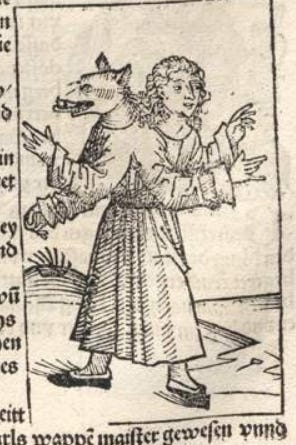
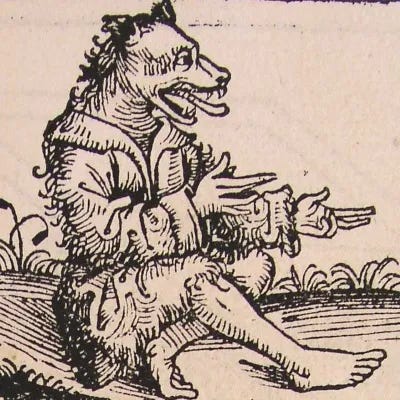
In a version of the tale before 1697, the hooded maiden experienced lycanthropy, having been eaten by the wolf and then eating the wolf. The wolf, as an initiatory and alchemical entity, assimilates into its identity those it devours, symbiotically integrating the grandmother and the hooded maiden, converting them into female werewolves. They come out of the wolf's belly, not digested, but profoundly transformed. This is a very primal motif, of the wolf as the witches' partner, a connection of the old woman and her alliance with the wolves. Ancient European traditions echo from the depths of time, about initiated women, the old women who became wolves, having a profound affinity with these animals.
In the present tale of Ananta the She-Wolf, Little Red Riding Hood is portrayed as a mature woman, a priestess of the thresholds she learned from her grandmother. The grandmother who was supposedly ill in her forest home was, in fact, a powerful old woman who lived with her pack of black wolves, far from civilization. At her death, the grandmother leaves her red cloak to her granddaughter, a symbol of power, care and transmutation. In this tale's universe, the affinity of these women with the wolves is so strong that they themselves transform into wolves on full moon nights.
Amanita
In this tale, Little Red Riding Hood is called Amanita, which, like her red cloak, makes a direct allusion to the classic fairy-tale mushroom, Amanita Muscaria or Fly Agaric, red with white spots. According to some authors, the cloak is a description of the character's deep relationship with the mysterious identity of the forest and the mycelial ecstatic sacrament forbidden by later religions.
Ananta
The wolf Ananta is named after the "mythical prefiguration'' of the "Milky Way" and the "lunar crescent," both variants of the "Primordial Night"1 and although she transmutes into a human, she never really loses her wild characteristics.
Pia dos Mouros
The love story between a human and a she-wolf is only possible in an enchanted reality where human beings contact and transgress the boundaries of their Cartesian world, accessing mysterious and primal realities. This novel was partly inspired by the Legend of the Pia dos Mouros (Pit of the Moors), a story of tragic love between a Christian man and a Moorish woman from the Chaves (Braganza) area, where both end up dying.2 Here, it is taken a bit further, bringing the power of female metamorphosis, a constant in the renewal of the potency of life.
The comb
The power of the comb that helps the transmutation of Ananta the She-Wolf was inspired by a passage from the Scandinavian story "The Lindworm"3 where, in one version, the bride has to rub the scales of her enchanted prince, transforming him from a gigantic snake into a human again.
The Braganza Brooch
The Braganza Brooch4, with its representation of the ancestral Iberian cosmos, served as territory for this tale, generating the guardians of darkness: boars, snakes, and wolves. "The Brooch can be divided into three planes: the Ocean, represented by the Serpent/Dragon of the World behind the warrior, and reinforced by the blue waves on top of his head; the Earth, where the warrior meets and fights the two-headed wolf; and the Underworld, represented by the boar's head at the lowest part of the Brooch, connected to the Earth by the cosmic umbilical cord to the wolf and connected to the Ocean by the second head of the Serpent of the World, thus closing the circle that is the Iberian cosmos."
Ancestral shamanic rituals
Several ancestral rituals with shamanic roots also surface in this tale:
The cyclical libations to the spirits of the place - visits to the boars and serpents with offerings of mushrooms, hazelnuts and grapes at each dark moon, ritually performed by the priestess and her pack of black wolves.
The ancient act of licking wounds, purging their infectious evil, as Ananta instinctively does to the hunter.
The pilgrimage and ritual of rebirth for love, asking permission from the original guardians.
The immobilisation of the body and being covered in earth recall ancient ceremonies of sensory deprivation to access other dimensions of reality. Shamans are said to walk between dimensions, working between death and life. Being covered in earth represents the burial of the body, allowing a ritual rebirth. Wrapping the body in animal skins soaked in psychoactive ointments, such as opium or hemlock, is part of ancestral visionary ceremonies.
The sacred bath in the stone basin in the centre of the forest is also important. Many of these pits are part of the Portuguese landscape and their use dates back to the end of time. The water's blessing, like a baptism or metamorphic initiation, coupled with the symbolism of the comb that untangles and removes the layers from Ananta's body, speaks of a ritual of union and transmutation. Let us also point out an important detail: among the Celtic and Germanic peoples, the custom of lying down on burial mounds to have a revelation, or to receive a gift, is a common practice of incubation, metamorphosis, and transformation. These are the so-called shamanic baths in natural or excavated rocks with associations to the folk tradition of agricultural fertility, part of initiatory death and rebirth in life.
Poppies
Poppies appear as keys of transgression between worlds and dimensions for their hallucinogenic capacities.
Why are these tales important now?
INTRO, tale list and chapter references.
THE TALES
The Goat Girl - Belinda & Benilde & What breathes through the Tale
The Shepherdess - Hystera and the thread of life & What breathes through the Tale
The Red Cloak - Ananta the She-Wolf Woman & What breathes through the Tale
Lucífera and the Cauldron - The Cinder Girl & What breathes through the Tale
Carisa - The First Wailer & What breathes through the Tale
Monster Sanctuary - Brufe and the Bears & What breathes through the Tale
Queen of the West Sea - Oki-usa and the Black Rock & What breathes through the Tale
FOLLOWING CHAPTERS
Remembering the Tales / Disappointed Moors - The Disenchantment of Growing up Storyless, Part I
Disappointed Moors - The Disenchantment of Growing up Storyless, part II
Washing Moors - Washing History, part I
Washing Moors - Washing History, part II
Builder Mouras - Mythical Territory
Warrior Mouras - Guarding and Protecting the Sacred - Part I
Warrior Mouras - Guarding and Protecting the Sacred - Part 2
Enchanted Mouras - The Power of Imagination
Spinning Mouras - Telling and Weaving the Stories
From the Book - Contos da Serpente e da Lua, Sofia Batalha(in portuguese)
http://arturjotaef-numancia.blogspot.com/2013/10/ofiussa-o-nome-mistico-mais-arcaico-da.html
(78) página 255 - A Mitologia dos Mouros, lendas, mitos, serpentes e tesouros, Colecção Mitologia e Memória, Alexandre Parafita, Gailivro Editora, 2006
https://en.wikipedia.org/wiki/King_Lindworm
https://herminiusmons.wordpress.com/2020/12/10/a-fibula-de-braganca-uma-representacao-do-cosmos-iberico/

